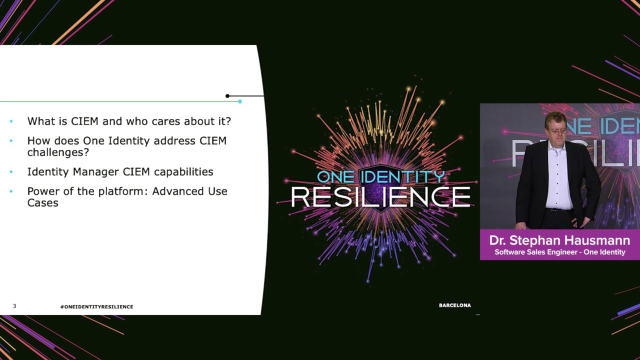CIEM at the intersection of IGA and PAM
 42:54
42:54
Related videos
Unifiez et sécurisez votre IAM avec One Identity Fabric
Découvrez comment One Identity Fabric connecte vos solutions de sécurité des identités dans un écosystème unifié, renforcé par l'IA pour permettre des analyses ...
00:45
Unifique y proteja su IAM con One Identity Fabric
Descubra cómo One Identity Fabric conecta sus herramientas de seguridad de identidades en un ecosistema unificado, mejorado con IA integrada para obtener inform...
00:45
Vereinheitlichen und sichern Sie Ihr IAM mit der One Identity Fabric
Entdecken Sie, wie die One Identity Fabric Ihre Identitätssicherheitstools zu einem einheitlichen Ökosystem verbindet, das mit integrierter KI für prädiktive Er...
00:45
Unify and secure your IAM with the One Identity Fabric
Discover how the One Identity Fabric connects your identity security tools into a unified ecosystem, enhanced with built-in AI for predictive insights, early th...
00:45
One Identity approach to AI in cybersecurity
Larry Chinski, VP of Corporate Strategy at One Identity, explores the dual nature of AI in cybersecurity, highlighting how the company leverages predictive AI t...
03:20
The future of digital identity: DNA, AI and blockchains
Privileged Access Management Strategist at One Identity, Alan Radford, explores the potential of DNA-based identity verification through blockchain technology a...
05:12
Managing identities in a growing organization: Lessons from SECURA Insurance
Joe Albers, Senior Information Security Engineer at SECURA Insurance, shares how effective identity management is crucial for compliance and security in the ins...
05:00
CEO keynote - The market is screaming for consolidation
Listen to Mark Logan, CEO of One Identity on the future of the identity fabric.
04:09
AWI trusts One Identity Manager to protect 50 years of scientific data
Andreas Thiele from the Alfred Wegener Institute (AWI) shares how One Identity Manager has streamlined the organization’s processes and improved security for th...
04:02
CEO keynote: Mark Logan - State of the Business
Listen to Mark explain the future vision of the organization and hear why we're the identity security company to partner with.
03:49
One Identity UNITE San Diego
Get a glimpse into the kind of fun you won't want to miss at our next UNITE conference party!
00:14
One Identity UNITE is heading to San Diego and Prague
Hear from Patrick Hunter, Co-Chair of One Identity UNITE, on what events we have coming up and why it’s the identity security event you simply can’t miss.
00:36
Securing your identity: The power of One Identity and Intragen partnership
Explore how Intragen and One Identity join forces to revolutionize identity security. In this short video, discover how Intragen helps clients map out their ide...
04:11
One Identity named leader in 2024 KuppingerCole Leadership Compass
Larry Chinski, One Identity VP of Corporate Strategy, explains why One Identity has been recognized as a leader in the 2024 KuppingerCole Identity Fabrics Leade...
00:36
Minimizing Your Enterprise Attack Surface
An enterprise attack surface is a sum of the entry and access points to your organization. Join Robert Byrne, One Identity Field Strategist, as he explains the ...
14:44
